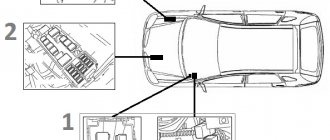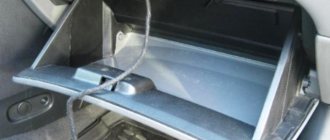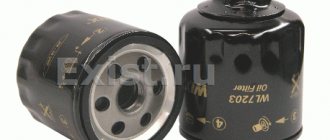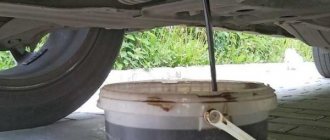Nissan Almera Classic is a modernized car based on the first generation Nissan Almera model, introduced on the Russian market in 2006. The car was also sold in Kazakhstan and Ukraine. The budget four-door sedan was equipped with a 1.6-liter gasoline engine with a power of 107 hp. s., aggregated with a manual transmission or automatic transmission. The basic version cost 398 thousand rubles. The standard equipment of the Almera Classic included one airbag, power steering, central locking, electric front door windows, as well as additional options: ABS, air conditioning, heated seats, radio and alloy wheels. Almere Classic's closest competitors include the Chevrolet Lacetti, Kia Spectra and Ford Focus.
Oil Nissan Almera Classic 1.6 engine
In Nissan Almera Classic, engine oil is most often used with a viscosity of 0W30, 5W30 and 5W40, these indicators are traditional for our country!
A good option among inexpensive analogues would be a domestic product:
- Lukoil Lux with article number 196256
- Lukoil Genesis 5W30
Both products from our manufacturer are excellent both in terms of tolerances and characteristics.
Original Nissan Almera Classic engine oil
But if you want to “feed” your car exclusively with original engine oil, then here it is:
- Nissan Motor Oil 0W30, article number KE900-90132 , cost of a 4 liter canister is about 2,300 rubles
From the instruction manual, the following original engine oils for Nissan Almera are also used:
- Engine oil NISSAN EXTRA SAVE X SJ, 10W-30, 1 l (semi-synthetic) - KLAJ210301
- Engine oil NISSAN EXTRA SAVE X SJ, 10W-30, 4 l (semi-synthetic) - KLAJ210304
- Engine oil NISSAN MOTOR OIL SL/CF, 5W-40, 5l (synthetic) - KE90090042
- Engine oil NISSAN STRONG SAVE X SM, 5W-30, 1 l (semi-synthetic) - KLAM305301
- Engine oil NISSAN STRONG SAVE X SM, 5W-30, 4 l (semi-synthetic) - KLAM305304
When purchasing, you need to rely on the recommendations of the car manufacturers and use only products that have certificates with the parameters that are reflected in the car’s operating instructions.
The viscosity level is important - for example, 5W30 or 5W40 - this parameter affects the resistance to temperature “overboard”.
Necessary spare parts, tools and consumables
To change the fluid in the mechanics of the Nissan Almera Classic B10, you will need the following devices, materials and spare parts:
- set of wrenches;
- an oil syringe or funnel equipped with a hose;
- an empty container into which the waste will flow;
- rags (without lint, you can take non-woven material) and a suitable solvent;
- special automotive sealant;
- new o-rings;
- new oil filter.
And, of course, a new transmission fluid is needed to replace it. For a complete replacement you will need about 7 liters, for a partial replacement - from 2.5 to 3.5 liters.
This is interesting: Which antifreeze is compatible with which
The best motor oil. does it exist?
Related posts:
Nissan Almera Classic is a modernized car based on the first generation Nissan Almera model, introduced on the Russian market in 2006. The car was also sold in Kazakhstan and Ukraine. The budget four-door sedan was equipped with a 1.6-liter gasoline engine with a power of 107 hp. s., aggregated with a manual transmission or automatic transmission. The basic version cost 398 thousand rubles. The standard equipment of the Almera Classic included one airbag, power steering, central locking, electric front door windows, as well as additional options: ABS, air conditioning, heated seats, radio and alloy wheels. Almere Classic's closest competitors include the Chevrolet Lacetti, Kia Spectra and Ford Focus.
Causes of leaks
To get rid of this problem, you need to understand the causes of fluid leakage. The most common of them for Nissan Almera Classic 2014, G15, N16:
- There is a problem with the gaskets or seals. It will be a little difficult to find which ones, since there are a lot of them in the engine, and problems can affect almost all rubbing parts of the power unit.
- There is a malfunction in the crankcase ventilation system. During engine operation, some of the exhaust gases enter the crankcase through the valve seals and piston rings. This creates additional pressure on the oil. Because of this, the liquid is squeezed out through the gaskets or seals, since they can no longer hold back such pressure.
- Poor quality motor oil in your engine. Fake liquid may be sold on the market and passed off as original. It is difficult to distinguish it from the real one, so many people often buy this fake. In an engine, the temperature rises to 300 degrees in the combustion chamber when it is running. Because of this, the fake changes its properties and comes out through the seals in considerable volumes. Much the same applies to waste - oil leaks through the seals in the pistons and enters the combustion area. This can be seen by the bluish color of the exhaust.
- One of the simplest causes of a leak is any damage to the crankcase. The crankcase can often be damaged by some kind of stone or hatch. That is why some manufacturers install some additional protection on it.
Regulations for changing oil in internal combustion engines
Experienced motorists and experts recommend changing the oil in the Nissan Almera Classic engine every 10-15 thousand km. Let us consider below the problems that the driver will have to face if he refuses a scheduled engine oil change.
- The car has not been used for a long time. In this case, moisture (condensation) accumulates inside the internal combustion engine, which enters the oil, as a result of which the lubricant loses its beneficial properties. This problem does not arise if the engine is regularly running, i.e. the machine is constantly in use. In this case, the water quickly evaporates under the influence of operating temperatures. Another problem associated with prolonged standing in the garage is the oxidation of oil with oxygen, which also destroys the beneficial properties of the oil.
- If you do not change the oil for a long time, dirt will accumulate in the engine, and major repairs cannot be avoided.
- The machine is often operated in mountainous and dusty areas, subjected to heavy loads (towing a trailer) in severe frosty conditions, as well as with constant temperature changes.
- In the absence of a scheduled oil change, its lubricating properties inevitably deteriorate, and then friction between moving mechanisms increases. This leads to an increase in the load on the engine, and it can “knock.” Fuel consumption may increase.
- In the absence of useful additives, the oil dissipates heat less well, resulting in overheating and reduced corrosion protection.
- Combustion and wear products accumulate in the engine, oil channels become clogged, etc.
Changing the oil in the Almera Classic engine is considered one of the simplest procedures for periodic maintenance of a car. You may need to fuss with it more than replacing the air or cabin filter, but changing the engine oil with your own hands is still possible. Along with the oil, the oil filter is also changed.
Leaks and problems
Leaks on Nissan Almera Classic engines are not common and occur mainly due to the lack of quality maintenance. But in any case, you need to look for the place where the oil is leaking individually.
But problems with fuel consumption and increased consumption occur regularly, especially on cars with mileage after 100 thousand kilometers. If the consumption from replacement to replacement is small, then you can try to select an oil that does not burn so badly. Or use the special LIQUI MOLY Pro-Line Motorspulung wash.
Type of oil
Today there are three types of lubricants on the market:
- Synthetic is the best oil at the moment. Recommended for modern foreign cars, which include Nissan Almera. Synthetics have excellent non-stick and anti-corrosion properties and also have a longer lifespan. This fact has a beneficial effect on the frequency of fluid replacement. In addition, this can be considered an undeniable advantage, given the high cost of the lubricant. Synthetic oil is well suited for high and low temperatures, never freezes, effectively cools parts and protects them from overheating.
- Mineral oil is the exact opposite of synthetic oil. It is not advisable to pour such a product into the Nissan Almera engine, unless there is a lack of funds for a more expensive oil. In addition, the use of mineral oil may be justified if the car has high mileage. You also need the thickest oil, and this can explain its main advantage - the absence of oil leaks in old cars with high mileage. Mineral oil does not have any other advantages, if you do not take into account the low cost.
- Semi-synthetic is an alternative that can replace mineral oil. It is a mixture of synthetic and mineral oils, and yet there is much more “mineral” in it. Despite this, the quality of semi-synthetic is much better than its closest competitor. Based on the above information, we can conclude that for Nissan Almera with low mileage, fill in synthetic oil, and with high mileage, you can save on semi-synthetic oil.
How to distinguish original Nissan oil by packaging
counterfeit on sale , the packaging of which is very similar to the original one , but there is still an external difference. There is no need to explain why it is dangerous to pour an unknown liquid with unknown properties into the engine. You just need to remember the main features of the original versus a fake and, of course, the best option not to buy a counterfeit at the price of the original is to buy oil from trusted suppliers. To combat counterfeits, the manufacturer added a security code to the back of the canister. To check the code you need to erase the protective layer. An online oil checking service has also appeared , which makes it easy to check by code whether the product is original or counterfeit.
Replacement frequency
The regularity of changing engine oil depends on several factors - regulations, as well as signs indicating the possible need for an oil change. According to the regulations, the oil in the Nissan Almera engine is changed every 15 thousand kilometers. But in difficult Russian conditions, the regulations will have to be reduced to 10 thousand kilometers or even more. This is a completely optimal indicator, at which the beneficial properties of the oil will not have time to lose their relevance. If you delay changing the oil, there is a high risk of encountering premature wear of engine components. As a result, a major overhaul of the engine or a complete replacement of the power unit may be required. Therefore, the oil should be changed on time, and sometimes even ahead of schedule.
What will be required for replacement?
To work, you will need a jack, an inspection hole, and even better, a lift. All professional technicians advise draining the lubricant when the engine is warm, since when the oil warms up it becomes thinner and flows out faster. Don't forget about safety and don't get burned. It is better to warm up the engine to operating temperature, and then leave the car for 10-20 minutes - this way the oil will cool down a little and will not burn you.
From tools and additional accessories you will need the following:
- rags;
- key to 14;
- filter key (if possible);
- container for draining old oil;
- set of heads with ratchet;
- screwdrivers;
- new oil filter;
- new oil in the amount of 3.2 liters.
Read about changing the oil in the Almera Classic transmission here.
Step-by-step instruction
Having read all the previous points, the replacement can begin. The following instructions must be followed:
Engine oil volume Nissan Almera classic
- To gain access to the plug, remove the protection from the engine.
- There is a plug in the oil pan; it needs to be unscrewed with a key set to “14”. Then drain the liquid.
- Next, unscrew the cap from the drain hole.
- This point, as well as the 5th and 6th points, are desirable, but optional. (Together with replacing the motor element, it is strongly recommended to change the oil filter. After replacing the fluid, particles from the old dirty filter can get into the new clean lubricant.) Unscrew the old element.
- Take a rag and clean the seat.
- Pour some liquid onto the new filter and place it in place.
Changing the engine oil
- Now tighten the drain plug.
- We take fresh motor oil
(the one you chose before starting the procedure; the product must be manufactured no earlier than 2014) and pour it into the hole. Remember that you need to pour in such an amount - no less than what was drained and no more. About 3 liters will come out. - Warm up the engine
and check for leaks. - Now turn off the engine and wait 10 minutes.
- Check the lubricant level and add if necessary.
- Tighten it and put everything in reverse order.
Done, the replacement of the liquid substance was successfully carried out. We hope you were able to decide which oil is best to pour into your car. If not, then you can leave a question in the comments.
How much oil is in a Nissan Almera classic engine?
Changing the Almera Classic automatic transmission lubricant
The design of the Nissan Almera Classic automatic transmission requires a complete or partial change of the lubricant. The automatic transmission is a Jatco RE4F04B. A partial oil change in an automatic transmission involves emptying the box cavity through the drain plug, followed by filling in new lubricant. Using this method, it will be possible to replace only half of the coolant in the automatic transmission, and the rest will be located in the torque converter.
A complete replacement can be performed in three ways:
- substitution;
- with dismantling the pallet;
- fast.
Using the replacement method requires the use of a special device that supplies fresh oil to the automatic transmission under pressure, gradually expelling the waste. This method is carried out at service centers with increased consumption of lubricant used.
Next, we will consider in detail the two remaining methods separately.
Detailed description of a complete automatic transmission oil change on your own
To carry out a complete change of coolant in an Almera Classic automatic transmission with removal of the pan, you will need to prepare the following material:
- crankcase gasket (3139731Х02);
- oil filter (3172831X01);
- new lubricant;
- funnel;
- WD-40.
Changing the lubricant in the Almera Classic automatic transmission begins with emptying the gearbox cavity through the drain plug. Subsequently, the following actions are performed:
- The automatic transmission pan is dismantled by unscrewing 21 bolts, draining the remaining oil;
- There are magnets on the inside of the tray. From them you can judge the condition of the rubbing mechanisms of the automatic transmission, by the amount of metal shavings;
- Subsequently, the tray is cleaned, including using WD-40;
- If there is a large amount of chips on the magnets, the oil filter must be changed;
- Then we install the pan with a new gasket and fill it with fresh transmission fluid.
Oil must be filled strictly according to the specified marks, checking the level on a warm engine.
Quick oil change in an Almera Classic automatic transmission
To quickly change the lubricant in the Almera Classic automatic transmission, you should prepare pliers, 2-liter plastic bottles, and new oil. To carry out the work you will need the help of one person.
A quick change of used lubricant in the Almera Classic automatic transmission is carried out in the following sequence:
- After opening the hood, you need to inspect the transmission dipstick. Next to it there are two hoses, one above the other. You will need to disconnect the top one by loosening the clamp with pliers. In this case, a couple of drops of oil may drain;
- We lower the dismantled end of the hose into the neck of the bottle;
- The assistant needs to start the Almera Classic engine, and the second person needs to give the go-ahead to stop the engine after filling the bottle with oil;
- Similar to the previous point, two more liters of waste are drained;
- 4 liters of new transmission fluid are poured through the dipstick. This volume can be limited if you plan to perform a partial change of lubricant. If you want to make a complete replacement, you should drain another four liters according to the previously described method. Then the same volume of new lubricant is poured in;
- The hose is installed on the seat, securing the end with a clamp.
Changing the oil in an Almera Classic automatic transmission using this method takes approximately ten minutes.
How much to fill
For the 1.6 Nissan Almera engine family, 5 liters of oil is sufficient. This is a very convenient volume, since this is exactly how much oil is offered in one canister - no less, no more. This way you don’t have to overpay for volume.
However, it is not possible to pour in the full volume of oil in all cases. For example, this is only possible with a complete oil change using a flushing compound. As for the partial replacement, it does not involve comprehensive cleaning, and because of this, traces of metal shavings and dirt deposits remain in the engine.
Fortunately, there is a proven method that allows you to do without an expensive complex replacement. This is a partial replacement, which is carried out in several stages - for example, 2-3 times every 500-600 kilometers. The third time, the engine components will be cleared of dirt deposits, and then it will be possible to fill in the full volume of fresh oil.
Instructions for changing manual transmission oil in a Nissan car
Let's look at the replacement process using the Nissan Tiida as an example. It is better to carry out the whole process in a pit.
1. Remove the engine and gearbox protection from the bottom of the car. In some cars, such protection may not be available, because is optional equipment.
2. Now we inspect the box, check: the right axle shaft oil seal, the left axle shaft oil seal, the axle shaft boots. They should not show any signs of oil. They may be wet from water, but should not be wet from gearbox oil.
3. This is what the drain plug of a manual transmission looks like:
4. This is what the filler plug looks like. It is also the oil level in the box:
5. Unscrew the manual transmission drain plug, having prepared it in advance and placing a container under it to drain the oil. Wait until the oil is completely drained.
6. Replace the O-ring on the drain plug. This must be done so that during further operation of the car the oil does not leak. This is what the old and new seal ring looks like:
7. Now take a filler syringe (can be purchased at an auto parts store) and a can of new oil and fill the transmission oil into the syringe.
8. Insert the syringe tube into the filler hole and use the plunger to pour oil into the box. You will need up to 3 liters of oil.
9. As we said above, the filler hole is also the level of oil volume in the manual transmission. Those. oil must be poured into the box until it runs back. As soon as the oil begins to slowly pour back out of the filler hole of the box, this means that there is already enough oil in the box.
10. We tighten the filler hole with a plug, put back the protection on the engine (if there was one) and that’s all.
This is how easy it is to change the oil in a manual transmission of Nissan cars.
Types of motor oils for Nissan Almera
The Nissan manufacturer is not a manufacturer or supplier of motor oils, limiting itself only to clear advice on their selection. According to the factory's advice, you should always adhere to the chosen brand of oil. Frequently changing oils of different viscosities leads to the unnecessary effect of mixing types of oils that differ in their multifunctional characteristics.
In the operating manuals, the manufacturer recommends using oil in the Nissan Almera corresponding to the following SAE viscosity grades:
Selecting engine oil viscosity depending on temperature
The indicated brands of oil, which fully comply with the advice of the Nissan car manufacturer, are produced by TOTAL. These oils meet the highest properties established by world standards.
Winter, summer and all-season oils differ from each other in their viscosity levels. Most of the oil brands on the current market are represented by all-season oil brands.
The market is replete with offers of mineral, synthetic and semi-synthetic oils. Synthetic oils are more “accurate” in these traits than mineral oils. They are not waxed, and because of this, they are more durable. With all this, synthetic oils are somewhat overpriced.
Remember that in market conditions there are many counterfeits of recognizable brands of world-class oil producers. Filling with such oil can cause harm to the engine.
Which oil to choose for manual transmission Nissan Almera Classis
The regulations for the manual transmission of this car indicate that the lubricant must have a viscosity according to the SAE classification 75W80, and according to the API, be at least GL-4. Of course, the manufacturer recommends using only original lubricating products. Transmissions from ELF, LIQUI MOLY Hypoid-Getriebeoil TDL 75W90 and other well-known global manufacturers of fuels and lubricants also have suitable approvals.
The oil volume that fits in the Almera Classic manual transmission is approximately 3.2-3.4 liters. Accordingly, for a complete replacement you will need up to 7 liters of new fluid. For partial – 2.5-3.5 liters.
Selection of oil by brands and parameters
Motor oils are selected according to certain viscosity and tolerance parameters. This way you can determine both the quality of the consumable material and its compatibility with Nissan Almera engines. Initially, you need to proceed from the parameters of the original oil, and then you can select a cheaper analogue oil.
So, the best option would be original synthetic all-season Nissan oil with viscosity characteristics of 5W-30 and 5W-40.
Among the best analogue oils are the companies Lukoil, Castrol, Rosneft, Mobile, ZIK, Elf, G-Energy and others.
Oil change procedure
Vehicle lubrication must be done in accordance with specified industrial instructions. When changing, Nissan Almera engine oil should be drained from the crankcase immediately after work, while it is still warm and drains well. When performing an oil change, it is useful to flush the engine crankcase with watery oil.
While checking the amount of oil in the engine, you need to turn off the engine and wait 15 minutes for the oil to combine into the crankcase. Of course, the quality of used oil can be assessed by checking the characteristics of its waste (consumption) for compliance with factory standards. Excessive oil consumption indicates its poor quality or its incompatibility with the Nissan Almera engine.
Filling necks and their caps are cleaned of dirt and dust before lubrication and are tightly closed after refueling. Pour oil through a fine mesh material. The oil level is kept under control with dipsticks or through control holes.
When changing the oil, the following rules must be observed:
- Use the correct grade of oil for lubrication.
- Observe the specified refilling intervals.
- Fill the oil to the normal level.
- It remains for our client to take measures to protect the oil from contamination during storage and refueling.
- Our client remains to take measures to eliminate unproductive loss of lubricant.
When filling oil, use suitable, unstained filling equipment.
1447265467_2283_4_1_0333333333333333
We clean the oil pan from dirt around the drain plug.
We clean the oil pan from dirt around the drain plug.
Using a 8-point square, loosen the drain plug.
To drain the used oil, use a wide container with a volume of at least 5 liters.
Unscrew the plug by hand and drain the oil.
Attention! Be careful - the oil is hot.
A steel washer is installed under the plug.











